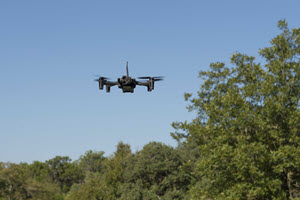By: Andrew Smith, TMD Public Affairs
 AUSTIN, TX -- Representatives from several government agencies and four drone companies gathered for a drone demonstration on September 15th, 2020 at Camp Mabry in Austin, Texas.
AUSTIN, TX -- Representatives from several government agencies and four drone companies gathered for a drone demonstration on September 15th, 2020 at Camp Mabry in Austin, Texas.
In recent years, drones have become popular as a low cost and low maintenance alternative for many missions which would have required manned aircraft. The ease of use brought by drones came with some security concerns as well, since many of these drones were built in China. The foreign nature of these drones does not comply with Federal Trade Commission government procurement practices that require half of the components of a drone purchased by the government be made in the United States.
In addition, the mapping capabilities and remote nature of the drones aroused security concerns. Due to these concerns, drone manufactures are now developing drones that are built in the United States using domestic components.
The Texas Military Department hosted the event to facilitate acquisitions of drones built to U.S. government standards in coordination with the Department of Defense’s Defense Innovation Unit. Using video conferencing, representatives from the developers explained the specifications of their company’s drones. Working drones were also flown in a series of short demos, and some prospective buyers even took the controls.
“This event is a great opportunity to take look at all the different systems made by US-based companies that are now approved by the secretary of defense and can be deployed in real-world missions without a waiver,” said Maj. Alexander Goldberg. Maj. Goldberg serves as the director for TMDX, Texas Military Department’s innovation unit, which organized the event. “The problem we were trying to solve, was that in any of our natural disasters our Texas Guardsmen are on the front line, whether it is COVID, or fires, floods and anything in between. To be able to take these small unmanned aircraft systems that are much cheaper than helicopters and actually have high-resolution cameras to do search and rescue on the front lines is a game-changer. And to have our first responders and agency partners here to get feedback and collaborate.”
At the conclusion of this event the attendees will analyze what is most effective and mission-capable for all parties involved. Agencies will then award innovation research contracts to the individual companies, so these projects can eventually be scaled into DOD-wide programs of record.
“We are looking for technologies that can real-time data back to leaders so they can make decisions,” said Capt. Meredith Zinni, intelligence officer assigned to the Texas Air National Guard. “We need to be able to make decisions ins real-time, we are fighting lag time of hours of things happening in the field, and when decision-makers are seeing the information."
While contracts have yet to be awarded to the companies building the drones, the ability of the Texas Military Department to facilitate this even in the midst of COVID restrictions is a testament to the Guard’s ability to adapt and overcome in a variety of complex environments.